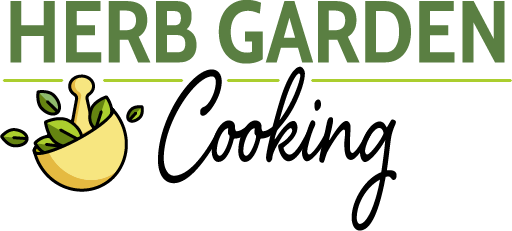The task of preserving garden herbs can seem daunting, yet it’s simpler than you might think. Let’s explore a variety of effective herb preservation techniques that are both easy to follow and highly efficient.
Table of Contents
Herb Preservation Tips & Techniques
- How to Dry Parsley: 4 Easy Methods
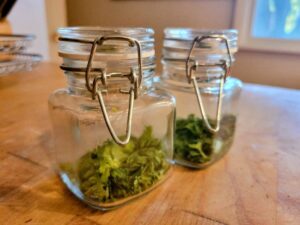 Drying parsley is a simple process that allows you to preserve this versatile herb for extended use. Explore 4 different methods for drying parsley, from air drying to using a food dehydrator, each with its unique advantages and considerations.
Drying parsley is a simple process that allows you to preserve this versatile herb for extended use. Explore 4 different methods for drying parsley, from air drying to using a food dehydrator, each with its unique advantages and considerations. - Can You Freeze Rosemary?
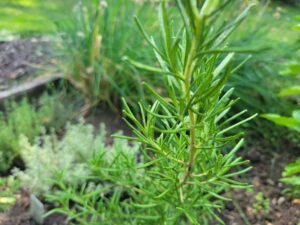 After a successful rosemary harvest from your herb garden, determining the best method for preserving it for your future culinary endeavors is crucial. Explore the feasibility of freezing your rosemary and how to do it.
After a successful rosemary harvest from your herb garden, determining the best method for preserving it for your future culinary endeavors is crucial. Explore the feasibility of freezing your rosemary and how to do it. - Can You Freeze Dill? Discover 3 Ways
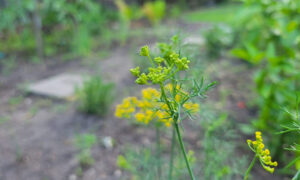 Discover the ideal way to preserve dill. Learn how to freeze dill and explore the benefits of freezing versus drying. Find out which freezing method suits your culinary needs.
Discover the ideal way to preserve dill. Learn how to freeze dill and explore the benefits of freezing versus drying. Find out which freezing method suits your culinary needs. - Can You Freeze Sage? Learn the Best Way and How to Do It
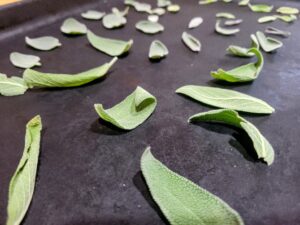 Learn how to freeze sage step by step using this preferred method. Extend the shelf-life of your freshly harvested garden sage and preserve it for up to a year.
Learn how to freeze sage step by step using this preferred method. Extend the shelf-life of your freshly harvested garden sage and preserve it for up to a year. - How to Freeze Herbs in Ice Cube Trays: Oil or Water?
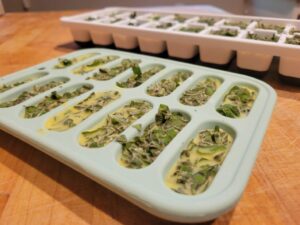 Discover the art of preserving the essence of fresh herbs year-round with frozen herb cubes. Learn how to prepare, freeze, and use these flavor-packed culinary gems while discovering whether oil or water is the superior choice.
Discover the art of preserving the essence of fresh herbs year-round with frozen herb cubes. Learn how to prepare, freeze, and use these flavor-packed culinary gems while discovering whether oil or water is the superior choice. - 6 Best Herbs to Freeze & Ways to Freeze Them
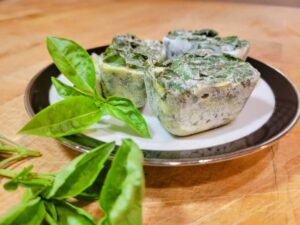 Discover the best herbs for freezing, learn why they are the top choices, and get freezing tips for vibrant flavors year-round.
Discover the best herbs for freezing, learn why they are the top choices, and get freezing tips for vibrant flavors year-round. - How to Dry Rosemary, Sage, Thyme & Oregano: Best Methods
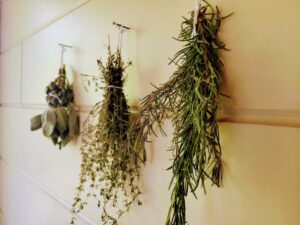 Learn how to dry sage, thyme, rosemary, and oregano using preferred methods like air drying and dehydration. Preserve the natural oils and flavors of your hardy herbs with step-by-step instructions.
Learn how to dry sage, thyme, rosemary, and oregano using preferred methods like air drying and dehydration. Preserve the natural oils and flavors of your hardy herbs with step-by-step instructions. - 7 Best Culinary Herbs for Infused Oils (& How to Infuse Them)
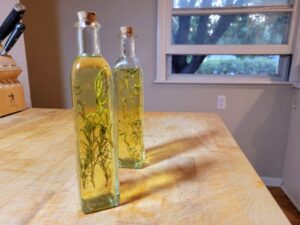 An underutilized method for preserving one’s herb garden harvest is to imbue their essence into …
An underutilized method for preserving one’s herb garden harvest is to imbue their essence into … - How to Dry Basil: 5 Different Ways
 Drying basil allows you to ensure it stays usable for an extended period of time. …
Drying basil allows you to ensure it stays usable for an extended period of time. … - How to Dry Herbs in an Air Fryer
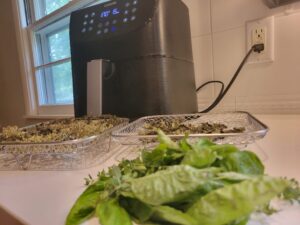 Discover tips and techniques from our herb drying experiment in an air fryer. Learn how to dry herbs with our without an air fryer dehydrator mode.
Discover tips and techniques from our herb drying experiment in an air fryer. Learn how to dry herbs with our without an air fryer dehydrator mode. - Harvesting Parsley: Useful Tips for Preservation & Storage
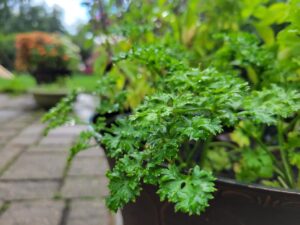 Learn the best techniques for harvesting parsley and storing it for later use. Discover how to keep your parsley plants healthy and thriving.
Learn the best techniques for harvesting parsley and storing it for later use. Discover how to keep your parsley plants healthy and thriving.
The Art of Herb Drying
Before beginning the drying process, prepare your herbs meticulously. Remove dirt and damaged leaves, then wash and dry them gently. Proper preparation ensures your dried herbs are clean and free of impurities.
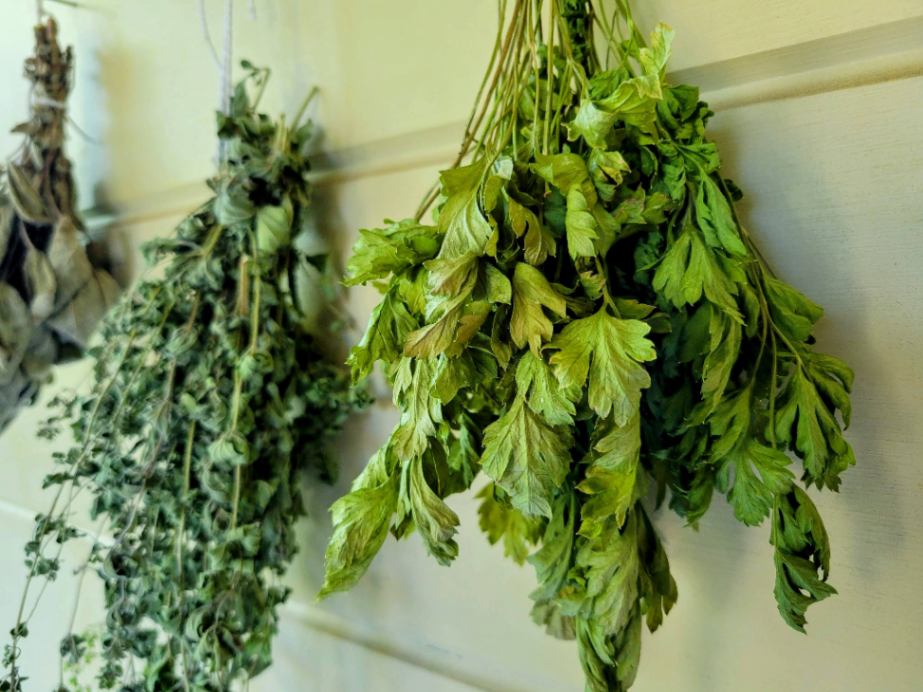
Air Drying: A Time-Tested Method
Air drying is a simple yet effective method for preserving herbs. To air-dry your herbs, follow these simple steps:
- Bundle your herb stems, securing their stems with twine or string.
- Hang the bundles upside down in a well-ventilated area.
- Allow herbs to air dry until they crumble when touched.
Once dried, remove leaves from stems and store in airtight containers.
Alternate Drying Techniques
If space or time constraints prohibit air drying, consider these alternative drying methods:
- Food Dehydrator: Use a food dehydrator for controlled drying. Spread your herb leaves on trays according to the manufacturer’s instructions.
- Oven Drying: For a quicker option, set your oven to its lowest temperature. Place herb leaves on parchment-lined baking sheets, leaving the door slightly ajar. Monitor regularly until dried.
Both methods work well for various herbs like basil, mint, parsley, and cilantro. By drying your herbs, you preserve their flavors and aromas for future culinary applications.
Herb Preservation & Storage Methods
Storing and preserving herbs is essential to maintain their freshness and flavor. By following the proper methods, you can ensure that your harvested herbs stay in optimal condition.
Safeguard Dried Herbs with Airtight Containers
After drying your herbs using one of the techniques listed above, remove herb leaves from the stems and store them in airtight containers away from light and moisture. This helps retain the flavor and potency of the herbs for an extended period.
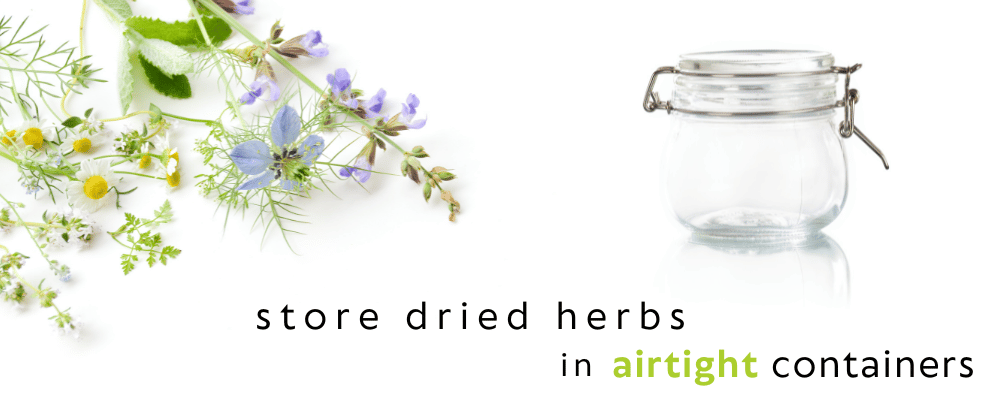
To store dried herbs effectively:
- Opt for glass jars with secure lids.
- Label containers with herb names and harvest dates.
- Keep them in cool, dark spaces like a pantry.
Preserve Herb with Freezing to Capture Freshness
Freezing fresh herbs is an excellent way to maintain their vibrant flavors. Wash and dry the herbs, then choose from two methods:
Frozen Herb Cubes
Freezing herbs in ice cube trays is an excellent way to preserve your garden herbs’ flavor and aroma. To learn the proper method for doing so, check out my article on how to freeze herbs in ice cube trays, and discover if it’s better to freeze your herbs in oil or water.

Freeze on Trays, Then Transfer to Airtight Containers
- Optional: Blanch herbs in boiling water for 10-20 seconds then pat dry. Blanching preserves color and flavor
- Lay herbs out on trays in a single layer.
- Freeze on trays for about an hour.
- Transfer to airtight bags, label and store in freezer.
Both of these methods allow you to conveniently grab individual portions of frozen herbs whenever needed while maintaining their original flavors.
To learn which herbs to freeze, read my article on the 6 best herbs to freeze and ways to freeze them.
Infused Oils and Vinegar: Flavorful Preservation
Elevate your dishes by making herb-infused oils or vinegar. To craft infused oils or vinegars:
- Choose fresh, clean herbs.
- Wash and dry herbs thoroughly.
- Place herbs in a sterilized glass jar, filling it halfway.
- Warm oil or vinegar and pour over herbs.
- Seal the jar and let them sit, allow infusing for weeks.
- Strain herbs before transferring to smaller bottles.
These concoctions amplify your culinary endeavors while providing long-term herb storage.
Essential Tools for Preserving Herbs
Having the right tools is crucial for successful herb preservation. Proper equipment streamlines the process whether you’re a seasoned gardener or a beginner. Here’s a list of essentials, each serving a specific purpose:
1. Drying Racks or Screens: Ideal for air drying herbs to maintain flavor through gradual evaporation, racks, and screens can provide an ideal surface for drying.
2. Twine or String: As an alternative to racks, use twine or string to tie herb bundles and hang them in a well-ventilated area for drying.
3. Airtight Containers or Jars: Store fully dried herbs in airtight glass jars or containers for protection against moisture.
4. Sealable Bags or Vacuum Sealer: Keep herbs fresh by using sealable bags or a vacuum sealer and freezing to prevent moisture and air exposure.
5. Labels: Keep track of freshness by labeling jars with herb names and harvest dates.
6. Ice Cube Trays: Convenient for freezing herbs in water or oil for easy portioning.
7. Infusing Liquids (Oil or Vinegar): Enhance dishes by infusing oils or vinegar with your harvested herbs.
Each tool has its role, ensuring your herb harvesting and preservation ventures are efficient and rewarding.
Frequently Asked Questions (FAQs)
How long do dried herbs last?
When stored properly in airtight containers away from light and moisture, dried herbs can be stored for up to one year. However, using them within six months for optimal flavor is best.
What is the best way to preserve fresh herbs?
The best way to preserve fresh herbs is to dry them thoroughly and then store them in airtight containers away from light and moisture. Freezing fresh herbs is another effective method for preserving the freshness of your herbs.
Can I freeze fresh herbs?
Freezing fresh herbs is a great way to preserve their flavors. Chop the herbs and place them in ice cube trays with a little water or oil. Once frozen, transfer the herb cubes to freezer bags for easy use in your recipes.
